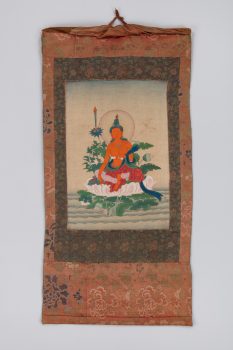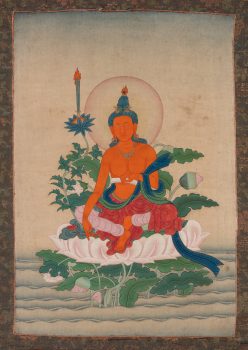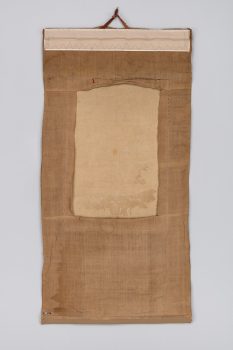Kham Province, Eastern Tibet
19th century
This is the gesture of the Buddha calling the earth to witness his awakening.
Kham Province, Eastern Tibet
19th century



This form of the bodhisattva of wisdom Manjushri does not fit typical textual descriptions. Normally an orange Manjushri would be energetically wielding his sword. Instead the artist chose the simple grace of a relaxed pose atop the rippling water of a lotus pond. This imbues the image with a quiet, contemplative feeling.Tibetan paintings are often created in sets, where a single theme is distributed among a number of canvases. This painting belongs to a set presenting the Eight Great Bodhisattvas, a group of Buddhist deities that represent Mahayana teachings. While the theme of this set is standard, these paintings are very unusual. They do not follow textual descriptions or other standard Tibetan visual conventions. We know a great deal about the creation of this set thanks to the detailed diaries of its patron, the great scholar and artist Situ Panchen (1700–1772). In 1732 he engaged the painter Trinle Rabphel of Karsho, a region in Kham Province, eastern Tibet, famous for artists. Situ had him trace an older painting by the great sixteenth-century artist Konchok Phende. These tracings were then painted by a group of artists from Karsho at Situ’s request.
The passing down of authentic Buddhist teachings from a teacher to a disciple or student, often in the form of a text in a ritualistic context.
In Buddhism merit is accumulated through engaging in positive actions that lead to positive results, such as better rebirths. Buddhists gain merit by making offerings, donating to those in need, reciting mantras, and other good deeds.
The transmission of teachings from one generation to the next, from teacher to student, traced all the way back to the Buddha without interruption. A complete lineage is essential in Tantric Buddhist practices as it makes the blessings of the teaching more powerful.
Beings who aspire to become fully awakened like the Buddha and are dedicated to helping others on the path to enlightenment.
Today, Tibetans primarily inhabit the Tibetan Plateau, situated between the Himalayan mountain range and the Indian subcontinent to the west, Chinese cultural regions to the east, and Mongolian cultural regions to the northeast. During the 7th to 9th century, Tibetan rulers expanded their empire across Central Asia, and established Buddhism as the state religion.
Get the latest news and stories from the Rubin, plus occasional information on how to support our work.